Blogs
Top 10 Ways to Use an AI Voice Generator in Daily Life

Not long ago, AI voice technology felt like science fiction. Now? It’s right in our pockets. With tools like AI voice generators, what used to sound like a robot is now smooth, lifelike, and helpful in more ways than you might think.
But why would an everyday person need it? Simple. AI voices can save time, cut costs, and offer more choices—from reading your emails aloud to making bedtime stories more fun. With support for many languages, it also makes communication easier across the world.
Let’s look at 10 practical ways to use an AI voice generator in your daily life.
1. Voice Notes and Reminders
Too busy to write things down? Just speak.
AI voice assistants like Siri, Alexa, and Google Assistant let you record thoughts on the fly. Whether it’s a grocery list or a work idea, using your voice is faster than typing. And with an AI voice generator, your reminders can be read back in a calm, clear voice—just the way you like it.
2. Language Learning and Translation
If you plan to learn a new language, you can try to use AI-powered apps. They can now speak sentences out loud in many different languages. This helps you hear correct pronunciation and understand tone. Traveling? Just point your phone at a sign or say a phrase, and the AI voice generator can translate and read it back instantly.
3. Reading Text Aloud
Eyes tired? Let your ears take over. Many AI tools now turn books, articles, and even emails into spoken audio. This is perfect for listening while driving, cooking, or exercising. It’s also a big help for people with vision issues or reading difficulties.
4. Helping Kids Learn and Play
Children love stories and sounds. You can use AI voice tools to create bedtime stories, read books, or even turn written stories into fun voices with different accents. It makes learning more exciting and can even help with pronunciation and vocabulary building.
5. Creating Videos or Podcasts
Don’t want to record your own voice? An AI voice generator can help you create voiceovers for YouTube videos, TikTox, or podcasts. You choose the tone—friendly, serious, fast, slow—and the tool takes care of the rest. It’s cheaper than hiring a voice actor and great for content creators.
6. Smart Home Control
Want to control your home with your voice? Smart devices like lights, thermostats, and speakers work well with AI voice assistants. However, you can take it further by setting up custom voice responses using an AI voice generator. For example, when you walk in, your home can greet you with “Welcome back, Sarah! It’s 72°F inside.”
7. Virtual Customer Service
AI voice generators can help answer customer calls with friendly, clear responses. You can script greetings, hours, and FAQs, then let the AI take over. This saves money and keeps your business running smoothly 24/7.
8. Daily Meditation and Motivation
AI-generated voices can guide you through meditation, breathing exercises, or even say positive affirmations in a soothing voice. It’s like having a personal wellness coach anytime you need it.
9. Custom GPS and Navigation Voices
Tired of the same old GPS voice? Some apps now let you customize your navigation voice using AI. Want your favorite celebrity voice giving directions? Or your child’s voice? AI tools can make it happen, turning boring trips into fun ones.
10. Supporting Elderly or Disabled Users
AI voice tools are more than just fun—they help people. Elderly users or those with mobility challenges can use voice commands for calls, reminders, or medical alerts. With a warm, clear voice, AI gives them more independence and peace of mind.
Common Questions
How do I make AI voices sound more natural?
Start with a good script. Use short sentences and natural speech patterns. Many tools also let you adjust speed, tone, and pauses. Try a few options until it sounds right for you.
Do I still need a real voice actor?
Yes—sometimes. For emotional content (like a movie trailer or a heartfelt story), a real human voice may still feel more “real.” But for daily tasks, explainer videos, or learning tools, AI voice generators do the job well.
What’s Next for AI Voice Technology?
We’re just getting started.
Real-time voice synthesis is becoming more common, which means AI voices will soon respond instantly in conversations. We’ll also see more emotion-aware AI, where the voice adjusts based on how you’re feeling—calm when you’re stressed, upbeat when you’re tired.
AI audio Tools like MiniMax AI are leading the way by making voices more natural, helpful, and personal.
Final Thoughts
AI voice tools are no longer just for techies or big companies. They’re for students, parents, creators, and everyday people. The next time you speak to your smart assistant or hear a computer read a story, remember—you’re using something once thought impossible.
And if an AI voice can handle your emails, bedtime stories, and trip planning… what will it do next?
